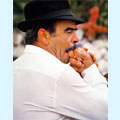GOMERAN WHISTLED LANGUAGE (EL SILBO GOMERO).
 To whistle in order to contact a person is quite normal, but usually once contact is made then spoken language is used.
To whistle in order to contact a person is quite normal, but usually once contact is made then spoken language is used.
The original nature of this kind of whistling named the Gomeran whistled language (silbo gomero) is that it is a unique means of language that allows the communication of any idea that the speaker has, with the same detail and precision of spoken language. It is possible to transmit messages as complex as “So and so is sick” or “Come and eat and by the way please bring water”.
 The “silbo gomero” is part of the cultural heritage of the area and it is quite natural to hear it in the sloping valleys of the island of La Gomera in the Canary Islands.
The “silbo gomero” is part of the cultural heritage of the area and it is quite natural to hear it in the sloping valleys of the island of La Gomera in the Canary Islands.
In the struggle to maintain tradition, its teaching was introduced in grade schools, although the origins of this peculiar method are still to be disentangled.
Keep in mind that those that learned it in their youth are already old people, and it is essential that the following present day generations are taught before it disappears completely.
It cannot be considered a language, but a substitute kind of tongue that is part of the people’s folklore, burdened with beautiful legends well able to stand the passing of time.